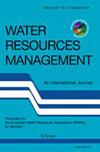Estimation of Mean Velocity Upstream and Downstream of a Bridge Model Using Metaheuristic Regression Methods
IF 3.9
3区 环境科学与生态学
Q1 ENGINEERING, CIVIL
引用次数: 0
Abstract
Abstract This study compares four data-driven methods, Gaussian process regression (GPR), multivariate adaptive regression spline (MARS), M5 model tree (M5Tree), and multilinear regression (MLR), in estimating mean velocity upstream and downstream of bridges. Data were obtained through multiple experiments in a rectangular laboratory flume with glass walls 9.5 m long, 0.6 m wide, and 0.6 m deep. Four different bridge models were placed at the 6th meter of the channel to determine the average velocities upstream and downstream. Different data-driven models were implemented with different combinations of effective parameters as input. They were evaluated and compared using root mean square error (RMSE), mean absolute relative error (MARE), and Nash–Sutcliffe efficiency (NSE). The results showed that the MARS had the best efficiency in estimating the mean velocity upstream of the bridge model. At the same time, the M5Tree provided the highest performance in estimating the mean velocity downstream. The MARS method improved the estimation accuracy of GPR, M5Tree, and MLR in the test phase by 23.8%, 45.1%, and 47.4% concerning the RMSE at the upstream. The M5Tree provided better RMSE accuracy of 31.8%, 70.4%, and 75.5% at the downstream compared to MARS, GPR, and MLR, respectively. The study recommends the MARS and M5Tree for estimating mean velocities upstream and downstream of the bridge.用元启发式回归方法估计桥梁模型上下游平均速度
摘要本研究比较了高斯过程回归(GPR)、多元自适应样条回归(MARS)、M5模型树(M5Tree)和多元线性回归(MLR)四种数据驱动方法在估算桥梁上下游平均速度方面的应用。数据是在一个长9.5 m、宽0.6 m、深0.6 m的矩形实验室水槽中通过多次实验获得的。四个不同的桥模型放置在6米的通道,以确定上游和下游的平均速度。采用不同的有效参数组合作为输入,实现不同的数据驱动模型。采用均方根误差(RMSE)、平均绝对相对误差(MARE)和Nash-Sutcliffe效率(NSE)对其进行评价和比较。结果表明,MARS对桥梁模型上游平均速度的估计效率最高。同时,M5Tree在估计下游平均流速方面提供了最高的性能。MARS方法在测试阶段GPR、M5Tree和MLR的上游RMSE估计精度分别提高了23.8%、45.1%和47.4%。与MARS、GPR和MLR相比,M5Tree在下游的RMSE精度分别为31.8%、70.4%和75.5%。该研究建议使用MARS和M5Tree来估算大桥上游和下游的平均速度。
本文章由计算机程序翻译,如有差异,请以英文原文为准。
求助全文
约1分钟内获得全文
求助全文
来源期刊

Water Resources Management
环境科学-工程:土木
CiteScore
7.40
自引率
16.30%
发文量
332
审稿时长
9 months
期刊介绍:
Water Resources Management is an international, multidisciplinary forum for the publication of original contributions and the exchange of knowledge and experience on the management of water resources. In particular, the journal publishes contributions on water resources assessment, development, conservation and control, emphasizing policies and strategies. Contributions examine planning and design of water resource systems, and
operation, maintenance and administration of water resource systems.
Coverage extends to these closely related topics: water demand and consumption; applied surface and groundwater hydrology; water management techniques; simulation and modelling of water resource systems; forecasting and control of quantity and quality of water; economic and social aspects of water use; legislation and water resources protection.
Water Resources Management is supported scientifically by the European Water Resources Association, a scientific and technical nonprofit-making European association.
 求助内容:
求助内容: 应助结果提醒方式:
应助结果提醒方式:


